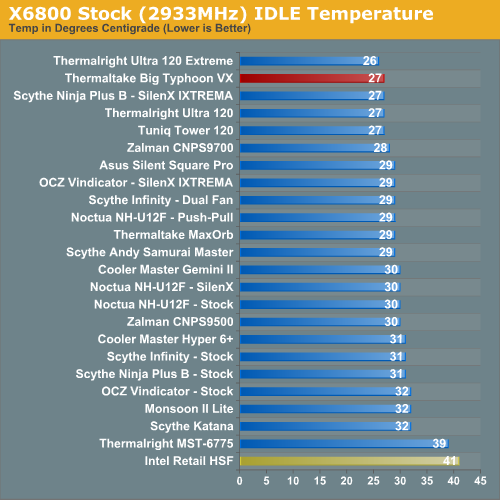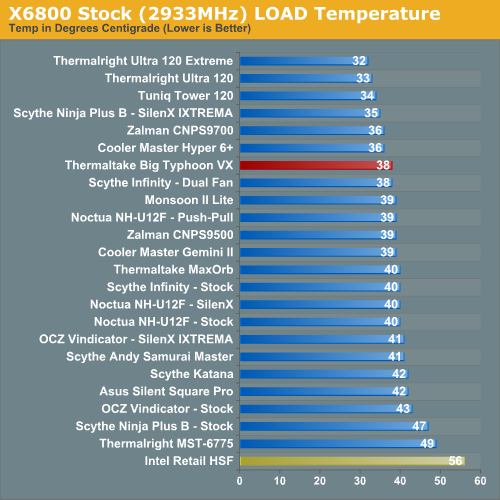Thermaltake Big Typhoon VX: Does VX Rule Cooling?
by Wesley Fink on June 7, 2007 5:10 AM EST- Posted in
- Cases/Cooling/PSUs
Cooling at Stock Speed
Some users will never overclock their CPU, but they still want to run the coolest CPU temperatures possible to enhance stability and extend CPU life. The Thermaltake Big Typhoon VX comes complete with a variable-speed high-output fan. Therefore we tested the VX cooler with the supplied fan at its maximum speed for the performance results.

Where the very good Intel stock cooler keeps the X6800 at 41C at idle, the VX managed 27C, which is outstanding performance. This is a significant improvement over the Intel stock cooler performance, and results are just 1C short of the best we have tested. The Thermalright coolers, at the top of our heatpipe tower performance charts, cool to 26C and 27C, and the Tuniq 120 maintains 27C. The Big Typhoon VX is very competitive in cooling at stock speed idle.
It is more difficult to effectively simulate a computer being stressed by all of the conditions it might be exposed to in different operating environments. For most home users CPU power is most taxed with contemporary gaming. Therefore our stress test simulates running a demanding contemporary game. The Far Cry River demo is looped for 30 minutes and the CPU temperature is captured at 4 second intervals with the NVIDIA monitor "logging" option. The highest temperature during the load test is then reported. Momentary spikes are ignored, as we report a sustained high-level temp that you would expect to find in this recording configuration. This test configuration roughly equates to an 80% CPU load test using Intel TAT.
Cooling efficiency of the Thermaltake Big Typhoon VX was then compared under load conditions at stock speed to the retail HSF and other recently tested CPU coolers.

The VX under load at stock speeds reached a maximum temperature of 38C with the included fan at its highest speed. This compares to the Thermalright coolers at 32C and 33C, the Tuniq at 34C and the Cooler Master Hyper 6+ and Zalman 9700 at 36C. Stock load performance is average to above average among tested coolers, which was something of a disappointment after the excellent stock idle results.
Some users will never overclock their CPU, but they still want to run the coolest CPU temperatures possible to enhance stability and extend CPU life. The Thermaltake Big Typhoon VX comes complete with a variable-speed high-output fan. Therefore we tested the VX cooler with the supplied fan at its maximum speed for the performance results.

Where the very good Intel stock cooler keeps the X6800 at 41C at idle, the VX managed 27C, which is outstanding performance. This is a significant improvement over the Intel stock cooler performance, and results are just 1C short of the best we have tested. The Thermalright coolers, at the top of our heatpipe tower performance charts, cool to 26C and 27C, and the Tuniq 120 maintains 27C. The Big Typhoon VX is very competitive in cooling at stock speed idle.
It is more difficult to effectively simulate a computer being stressed by all of the conditions it might be exposed to in different operating environments. For most home users CPU power is most taxed with contemporary gaming. Therefore our stress test simulates running a demanding contemporary game. The Far Cry River demo is looped for 30 minutes and the CPU temperature is captured at 4 second intervals with the NVIDIA monitor "logging" option. The highest temperature during the load test is then reported. Momentary spikes are ignored, as we report a sustained high-level temp that you would expect to find in this recording configuration. This test configuration roughly equates to an 80% CPU load test using Intel TAT.
Cooling efficiency of the Thermaltake Big Typhoon VX was then compared under load conditions at stock speed to the retail HSF and other recently tested CPU coolers.

The VX under load at stock speeds reached a maximum temperature of 38C with the included fan at its highest speed. This compares to the Thermalright coolers at 32C and 33C, the Tuniq at 34C and the Cooler Master Hyper 6+ and Zalman 9700 at 36C. Stock load performance is average to above average among tested coolers, which was something of a disappointment after the excellent stock idle results.










34 Comments
View All Comments
rjm55 - Thursday, June 7, 2007 - link
Maybe the real point is that those who bought these down-fan coolers for better cooling are just disappointed to find out they don't work as well as the top guns.stepone - Thursday, June 7, 2007 - link
The point I was making was that the 120 VX (& down blowers inparticular) benefit more from exhaust fans than tower coolers do and a proper case setup will nearly always include at least 1 120mm extraction fan.Seriously who buys an after market HSF & then uses no case fans (HTPC users maybe but most HSF units will be 2 big for those cases)?
As for your sour grapes implication, you're being very close minded...
Is it not possible that other people's opinions & real world experience of the 120 VX could be different & that they're trying to simply get people to take a 2nd look at this HSF instead of being petty individuals in a vindictive jealous rage trying to steer others to the same mistake?
As for Anand techs dissing of Hexus's tests this doesn't seem fair.
Sure they used a different testing methodology than yours but that doesn't make their results worthless and although I disagree with some of their methodology as well it doesn't negate their results. Just as it doesn't negate yours.
To me these 2 reviews make it clear that a case with good ventilation & 2-3 fans will benefit the 120 VX more than a tower cooler & perhaps skew you in that direction but cases with 1 or no fans should go with a tower cooler for better results.
And yes I am happy to seed the crown of best HSF to the Ultra 120 as I do believe it is the best around at the moment. I just believe that the 120VX is a better cooler in real world cases then you give it credit for as your test setup does not reflect the type of system setup that most people will be using in their PC's.
Still good job Anand Tech for providing a review at all.
Thanks... (boy that was way too long :-)
rjm55 - Thursday, June 7, 2007 - link
Am I dense? If the down facing fan coolers need case fans to approach cooling as well as the towers with side fans isn't this proof the towers cool better?It is also interesting that Wesley found the down fans and side fan models both benefited from adding a case fan. So what's the point?
DaveLessnau - Thursday, June 7, 2007 - link
As I mentioned in your last heatsink review, it's because you don't have a case fan. All you're doing with the down-facing fan on this heatsink is circulating the same hot air around and around the case. All it does (all it CAN do) is get hotter. No one in their right mind would run a computer without at least one case fan, ESPECIALLY when over-clocking. In this artificial (and incorrect) test environment you've created, those side-blowing heatsink have a definite advantage since they can force some hot air out through that empty case fan slot.
I realize you did this test in the same environment as the last one so you could compare apples to apples. But, there's no point in a proper comparison across tests when the tests themselves are faulty. Put the case fan back in your test bed and at least re-test one down-blowing and one side-blowing heatsink.
Wesley Fink - Thursday, June 7, 2007 - link
Our current case does have a PS fan that removes hot air from the top of the case and rear vents to exhaust rear air, but no case fans. All coolers were tested under these consditions.We did test 2 of the down-facing coolers with a rear case fan installed. Cooling performance was improved a few degrees, but overclock remained about the same. We then tried the rear case fan with two of the heatpipe towers. Cooling performace was also improved using a case fan on the heatpipe towers but overclock was almost the same. We suspect that if we were testing with much lower output fans the case fan would make more of a difference.
In the end we would need to retest all coolers with a case fan installed, not just the down-facers. Right now we doubt it would reveal more than we already know, based on quickly checking 4 coolers with a case fan.
Our new test bed will include a "quieter" variable speed PS with a different fan configuration. We will also include a large low-rpm case fan. We do plan to retest a cross-section of the coolers for new baseline results when the new cooler test bed is finalized and updated.
Martimus - Thursday, June 7, 2007 - link
I know that I have written in both of the previous reviews that blowing the hot air back onto the component is counterproductive, and that turing the fan around would help that part at least. But, the side blowing fan is just a better design. It has better airflow, and doesn't end up with the turbulence and back pressure that a downward facing fan has. Side blowing fans aren't always practical though, because they stick out much farther, and cause much more strain on the motherboard.strikeback03 - Thursday, June 7, 2007 - link
The height of the VX is 150mm, including the control knob on top, so say 135mm for the top of the fan. Most of the weight is far away from the motherboard. The Tuniqstrikeback03 - Thursday, June 7, 2007 - link
typo submitted the comment unfinished.The Tuniq is 155mm tall and the Thermalrights 160.5, and I would not be surprised if they put less of a moment on the motherboard due to the mass not being all concentrated at the far end.
Bull Dog - Thursday, June 7, 2007 - link
Very nice review. I love the dig at Hexus at the end. Their review really did piss me off in the fact that they used such a crappy fan on their Ultra-120.jkostans - Thursday, June 7, 2007 - link
I agree, this review is 10x better than the Hexus one. The Hexus review was a slap in the face to legit reviews.